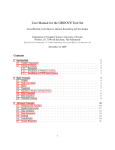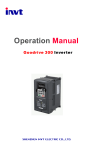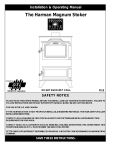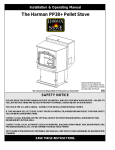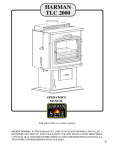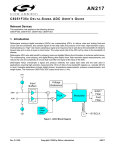Download notice concerning copyright restrictions
Transcript
NOTICE CONCERNING COPYRIGHT RESTRICTIONS This document may contain copyrighted materials. These materials have been made available for use in research, teaching, and private study, but may not be used for any commercial purpose. Users may not otherwise copy, reproduce, retransmit, distribute, publish, commercially exploit or otherwise transfer any material. The copyright law of the United States (Title 17, United States Code) governs the making of photocopies or other reproductions of copyrighted material. Under certain conditions specified in the law, libraries and archives are authorized to furnish a photocopy or other reproduction. One of these specific conditions is that the photocopy or reproduction is not to be "used for any purpose other than private study, scholarship, or research." If a user makes a request for, or later uses, a photocopy or reproduction for purposes in excess of "fair use," that user may be liable for copyright infringement. This institution reserves the right to refuse to accept a copying order if, in its judgment, fulfillment of the order would involve violation of copyright law. Geothermal Resources Council, Monograph on The Geysers Geothermal Feld, Special Report No. 17,1991 DESIGN OF STEAM GATHERING SYSTEMS AT THE GEYSERS: A STATE-OF-THE-ART REVIEW Harry Veizades and William J. Cain VeiZades &Associates, Inc. 90 New Montgomery Street, Suite 707 San Francisco, Galifimia 94105 ABSTRACT Geothermal gathering system designs have evolved at The Geysers KGRA to meet ever changing operational and design parameters. New technologies have enabled more efficient and economical designs to be developed. This paper lists some of the developments that have occurred between 1973 and the present and presents the writers' view of the current state-of-theart design and construction of the geothermal gathering facilities. Topics covered are advances in pipeline route selection, piping design techniques, selection of piping materials and components, development of details, typical design criteria and condensate removal and collection systems. following sections discuss the state-of-the-art of various aspects in the design of gathering systems at The Geysers. Pipeline Route Selection The mountainous and steep terrain of the Mayacmas Mountains requires careful selection of pipeline routes between wells and the power plants they supply. Such factorsas access for construction and flexibility for thermal expansion must be taken into account in selecting the routing. Condensatecollection lines normally parallel the steam gathering lines. In order to minimize pumping of condensate, it is important to minimize sags in the steam and condensatepipe alignment. Ideally, the steamand condensate line alignment should have no sags, allowing the collection of condensate by gravity to a single condensate storage facility for pumping. Environmental constraints play a major role in route selection. Most of the developments at The Geysers are located along ridge tops and they are highly visible for many miles. Careful selection of piping routes is required to minimize the visual impact and noise transmission from the various system components to nearby communities. This is particularly important in areas where communities are located within line of sight of the facilities. In some areas the vegetation is very fragile and pipeline alignment INTRODUCTION The typical gathering system at The Geysers consists of the facilities necessary to convey geothermal steam from the steam wells to the power plant. It includes facilities to collect condensate generated during start-up and operation, m o v e rocks and rock particles from the steam, remove water and rock dust, inject water for steam conditioning, convey excess condensate from the power plant to a well for reinjection into the reservoir and vent steam during start-up and power plant outages. A simplified piping and instrumentation diagram of a typical steam gathering system is shown in Figure 1.The 285 Design of Steam GatheringSystems at The Geysess:A Statmf-the-Art Review WELL SITE r----- I VENT, TYPICAL / -CONDENSATE POT 8 LIQUID DRAINER TYPICAL 7 I’ SCRUB WATER INJECTION U RUPTURE DISK MUFFLER \ WELL LINE ISOLATION VALVE WELL LINE CONDENSATE COLLECTION -- GATHERING SYSTEM COND COLL ECTlON STEAM GATHERING ____ ____ ---__ ---\ CONDENSATE COLLECTION BASIN TYPICAL I I I ToELE( .,...- -Y I STEAM GATHERING SYSTEM DIAGRAM WELL WIRE LINE VALVE - WORKING VALVE MASTER VALVE -- WELL ///S//&/LW/L.Y/LZ/& II -- - LINE CONDENSATE COLLECTION T Y P I C A L W E L L LINE DIAGRAM Figure 1. Simplified steam gathering piping and instrumentation diagram. 246 -1 ~ TO CONDENSATE COLLECTION BASIN Harry Veizades and William J. Cam model pipe restraints at pipe supports and gaps at the guides and by iterative techniques provide an accurate determination of piping behavior, pipe stress and pipe movements. Several computer programs are available for analyzing piping systems. Before any program is used, however, the designer must determine whether the program accurately models the piping system and the pipe supports.The proper modeling of incline supportsis very important in selecting computer programs for analyzing piping systems in the rough terrain at The Geysers. The dynamic analysis capabilitiesof the computer p m gram allow the designer to investigate system performance under seismic events and flow-induced vibrations. The concepts for designing steam gathering pipelines in mountainous terrain differ from piping designs within the confines of a power plant. The typical power plant piping is restrained to minimize loads on equipment nozzles. Expansion is accommodated by expansion joints. The steam gathering piping outside the power plant, with its meandering layout as it follows roads, trails, ridges or topographic featuresis much more flexible and can accommodate large thermal movements without becoming over stressed. The concepts we have followed in designing piping systems over the mountainous Geysers terrain are: 1.Take advantage of the flexibility that the piping layout offers. Often the piping layout has sufficient flexibility to accommodate expansion without the use of expansion loops. 2. Select supportsand anchors to provide maximum flexibility. Anchorsare spaced far apart (between500 to 700 feet) and located to control the pipe movements without reducing piping flexibility for thermal expansion. 3. Selectively restrain pipe for seismic and wind loads. Such restraintsare selected so that they do not unduly induce high support loads due to thermal expansion. must be routed around these areas.Removal of vegetation for construction must be minimized. Removal of vegetation creates barren areas that erode and produce run-ffinduced siltation of streams. Access for construction is another important factor. Many of the slopes in the area are very steep. One unpublished study (Veizades & Associates, 1981)of slopes at The Geysers revealed that in an area of about 15 square miles slopes exceeded two horizontal to one vertical over 75 percent of the area. Many of these slopes are covered with highly fractured and hiable shale. We have found that route selection is the most critical aspect in the design process and should be assigned to an experienced engineer. It is important that the engineer be well versed in geothermal piping construction techniques, geotechnical evaluation, surveying,behavior of piping under thermal movements, condensate line hydraulics and environmental matters. Using maps produced by aerial photography, several proposed alignments are studied on paper to determine the controlling parameters in route selection. With these results in hand, the engineer then performs a field reconnaissance of the most promising alignments. The final route selected is then marked for clearing and right of way construction. Following right of way construction, a precise survey of the proposed alignment is made. This survey provides the basis for preparation of construction drawings and for piping construction. Piping Design Techniques Lengqiust (1973)set forth somebasic design techniques and details that have been used in the design of several gathering systems at The Geysers. Since then, several aspects of piping design have advanced through the use of computer programs for flow and stress analyses. It is now possible to make rapid, cost efficient analyses in a matter of hours on a personal mmputer. Flow analyses in The Geysers were traditionally done by hand using the empirical Fritzche equation for pressure drops. For a large gathering system, this could become quite tedious when the designer wished to consider multiple scenarios of flow. Today, computer based flow analyses are performed using the Darcy-Weisbach formulation with steam properties automatically generated. This process makes it possible to perform parametric studies to examine how velocity and pressure change at any desired point in the piping system. This enables the designer to optimize the selection of pipe sizes and check system performance under various steam flow scenarios. The advances in computer-assisted stress analysis techniques have enabled the designer to develop a much better understanding of the behavior of piping systems. Useof computer programs such as AUTOPIPE (Engineering Design Automation, 1987) enables the designer to 4. Design supports and anchors to restrain thermal, seis- mic, wind, friction and thermal loads. This approach in designing piping systems results in a balanced design that minimizes stress and support loads. Supports for steam gathering lines are typically constructed as a stanchion as shown in Figure 2. The bearing assembly is welded in the field. This allows for final horizontal and vertical adjustment of the pipe bearing assembly to compensate for stanchion misalignments due to construction tolerances. Loads on the stanchions due to thwmd expansion, friction, scismic and wind loads are resisted by lateral bcaring against the soil or rock. Conservative loads for dcsigning the supports arc used to produce a safe support design. 247 Design ofSteam Cathering S y s t e m at The Geysers:A State-of-the-Art Review E no1 POSITION TE COLD POSITION VENT HOLE \ 1 PIPE STANCWION I I I I I CONCRETE CAISSON IN OWILLED HOLE I I I I I I I I I I I I SUPPORT ANCHOR Figure 2. Typical pipe support and anchor stanchions. HCI, H2S and C02 in the geothermal fluids as well as chemicals added in the various abatement processes results in fluids with highly corrosiveto passive properties. The primary piping material used at The Geysersis ASTM A53, Grade B. The pipe is usually furnished seamless, ERW or DSAW. Seamless pipe is normally used for the steam lines from the wellhead to the root valve at the header. Seamless pipe is less susceptible to cracking by The design of the supports and anchors is based on the Uniform Building Code (U.B.C.) (International Conference of Building Officials, 1988) provisions for nonconstrained pole type supports (Section 2907 (g) 2.A). The dowable soil bearing values are conservatively selected by the engineer based on observations made during reconnaissance after construction of the pipeline right-ofways. The ultimate capacity of the supports is several times the design capacity detennined under the U.B.C. provisions. This allows the supports to accommodate unexpected loads resulting from construction sequencing, differential earth movements and impact loads.Although these loads may produce additional lateral deflectionof the supportsbeyond the design values, the flexible piping systems can accommodate them without over stressing. The standard shoe design used at The Geysers in 1973 was a "tee" section welded to the pipe with or without a saddle. This design experienced some hairline cracks in the pipe in the heat affected zones at the point where the shoes are welded to the pipe. To correct this problem a "strap on" type shoe design has been adapted on recent installations (Figure 3). This design has eliminated the cracking problem. SADDLE WEB PLATE PLATE .GUSSET B E A R I N G BAR STANCHION HOT POSITION 4 4- COLD PO SlTlON PIPING MATERIALS Materials for gathering systems must perform well under widely varying process conditions.The presence of Figure 3. Strapon support shoe. 248 Harry Veizades and William J. Cain Stress corrosion, cracking at welding neck flanges and at welding fittings. This cracking manifests as a hairline crack. The presence of H2S and arseniccompounds in the steam may contributeto this cracking.The actual mechanism or cause of this cracking has not been conclusively determined.This cracking,while costly to repair, is not catastrophic. To combat the cracking problems the following methods have applied in the design of piping systems: Minimize welding on the pipe. Use strap-on shoesand brackets rather than welding them to the pipe. Preheat and post heat when welding flanges. Stress relieve fabricated spools downstream of control valves and other restrictions. Increase thickness of piping material downstream of control valves and other restrictions. Avoid control valve settings that induce high fquency vibrations. Use control valves with noise reduction times. Use of low hydrogen welding rods. high frequency vibrations produced by the control valves orifice restrictionsand high velocities. The use of carbon steel piping since the 1960shas been successfulin geothermal steam service. A silica coating of the pipe interior has protected the pipe from mmsion on systems with relatively clean steam. Quite oftena corrosion allowanceisnot provided on such systems.Recently, however, some areas of The Geysers steam fields have produced steam with high concentrations of chlorides. These chlorideshave made a devastatingcorrosiveattack on the steam lines. To combat this problem several methodshavebeenstudied.Amongthosearetheuseof more exoticpiping materials,acceptanceof reduced use operating life with scheduled replacement of piping, and scrubbing of the corrosive agents. The most cost effective method of corrosion mitigation has been the installation of scrubbing systems to remove or neutralize the corrosive agents. A recent innovationin piping construction is the use of induction heat pipe instead of welding fittings for angle changes in pipe systems. The induction bends minimize field welding, expedite field installation,minimize radiographic inspection and reduce pipe stress due to lower stress intensification factors. The use of induction bent pipe with a bend radius from three to five times the pipe diameter has been very successfuland cost effective. The condensate transport piping systems handle geothermal condensate that can be divided into two categories: 1.Highly oxygenated fluids such as excess condensate at the cooling tower slated for reinjection, and 2. Steam condensate collected for drip legs along steam lines and from separators.This condensate is normally hot and contains some dissolved solids and nonmndensable gases but has not been exposed to atmospheric oxygen. The oxygenated condensate is highly corrosive and piping materials used for its conveyance are stainless steel, epoxy or cement lined carbon steel pipe or plastic pipe. The nonoxygenated condensate is not as corrosive and piping material used for transporting it is normally carbon steel with a corrosion allowance. Pumps used in condensate systems are specified with all wetted parts made from stainless steel. TYPICAL DESIGN CRITERIA Most steam gathering systems at The Geysers are designed using the ANSI B31.1 piping code and the following design parameters: Well Steam Lines: (From wellhead to header) Design Pressure:500 psig (full wellhead pressure) Operating Pressure: 120 to 500 psig Temperature: 490°F (Saturatedsteam temperature)* Flow velocity: 250 ft/sec maximum System Test Performance: 500 psig (full wellhead pressure) Insulation: %inch for smaller diameter pipes and 4 inch for larger diameter pipes Fiberglass with density of 3 lbs/cu ft and aluminum jacketing. Flange Rating: ANSI Class 300 Overpressure Protection: None Gathering Lines Design Pressure: 200 psig Operating Pressure: 105 to 165 psig Temperature: 340°F (Saturatedsteam temperature)* Flow velocity: 50 to 250 ft/sec System Test Pressure: 240 psig Insulation: 4-inch Fiberglass w/density of 3 lbs/cu ft and aluminumjacketing Flange Rating: ANSI Class 150 Overpressure Protection:Rupture disks at 190 psig. PIPE CRACKING The piping systems at The Geysers have performed extremely well in 30 years of service. There have been, however,occasionswherecrackingofpipesoccurred.The cracking can be attributed to the following: High frequency vibrations induced by steam flows downstream of orifice restrictions or control valves. This cracking normally starts at a weld heat affected zone. The cracking is sudden and catastrophic. 'When systems arry suprhtnted steam heoppiupriate temperutureshould be usad. 249 Design of Steam Gathering Systems at The Geysers: A Stateof-&Art Review CONDENSATE REMOVAL AND COLLECTION SYSTEMS Condensate generated in steam piping by heat losses and during warm-up is collected in a seriesof condensate drop pots (Freeston,1981)along the steam lines. Condensate is automatidly removed from the drop pots with float controlled "liquid drainers."The use of various types of steam traps has been unsuccessful.Presently, the Armstrong and Nicholson drainers are the only successful devices for condensate removal. Collection lines, insofar as possible, use gravity flow to convey the condensate to a collection tank or sump from where it is pumped or trucked to the cooling tower basin for reinjection. The steam from wet wells is scrubbed to remove moistureby the use of separators. Condensateh m separators is discharged by valving or drainers to the condensate collecticm system. Recent practice has been to inject water into the steam upstream ofthe main separator to enhancethe separator's abilityto remove particulatesand silica that are carried by the steam. Careful control of this water injection has been shown to reduce the amount of silica deposited on the blades of the turbine. The condensate system is normally designed to handle this additional load from the steam scrubbing operations at the separators. CONCLUSIONS This paper has pmented a broad overview of the developments in gathering system designs that have occurred since Lengqiust's landmark paper in 1973. It should be noted that the design of geothermalgathering systems at The Geysers has been and continues to be an evolutionary process. The designermust keep abreast of the various operationaland performance problems and develop piping designs to solve such problems. Communication between various operatorsand designerscontinues to advance the state-of-the art. Only by the close cooperation and free flow of information between the various operators and designers, can advancements be made in the design of steam gathering systems. REFERENCES Engineering Design Automation, 1987. AUTOPIPE User's Manual, Vesion 4.1. Engineering Design Automation, Berkeley,CA. Freeston, D.H., 1981.Condensationpot design:Model tests,Geothermal ResourcesCouncil Transactions,vol. 5, p. 421. International Conference of Building Officials, Uniform Building Code, 1988edition. Lengqiust, R. and Hamen, A.L., 1973. Geothermal steam piping at Big Geysers, California, U.S.A., 1 W 7 5 . Veizades and Associates,Inc, 1981. Slope map from unpublished study for OccidentalGeothermal, Inc







